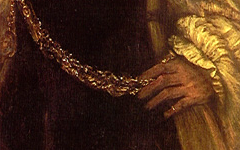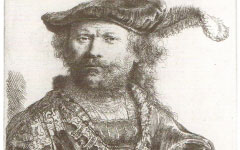Rembrandt’s Man in Armour (1655) and Minerva (c.1655)
Two quite similar paintings by Rembrandt, now in Lisbon and Glasgow but both painted around 1655, depict figures in armour with uncertain titles and identities.

L: Rembrandt, Man in Armour or Alexander the Great (1655) Oil on canvas. Kelvingrove Art Gallery and Museum, Glasgow.
R: Rembrandt, Minerva or Pallas Athena (c.1655) Oil on canvas. Calouste Gulbenkian Museum, Lisbon.
Click image to enlarge.
One (right) is now called Minerva because she has long, curly hair and the owl on her helmet is the goddess' symbol.1 Still, to me, she looks like a male youth with signs of hair on her upper lip. The other looks visibly male. Once described as Alexander the Great, it is now called Man in Armour.2 Yet contrary to conventional belief in the significance of narrative these two contemporaneous images are so similar in form that their meaning must be too.
Click next thumbnail to continue
For starters, all followers of the Inner Tradition in any of its many forms over the centuries has sought Wisdom which in its pagan paths is just another way of saying God. Attaining a state of pure wisdom or unity with God were similar. Indeed Rembrandt who sought wisdom, or understood the process like all great poets, was one of them, seeking to discover in his own soul that divine element that makes us both fully human and God-like, at one with nature and divinity. The wise owl then is likely to represent the perfection and purity of the artist's mind, no matter whose head is in the helmet.
Click next thumbnail to continue

L: Rembrandt, Minerva or Pallas Athena (c.1655)
R: Bazille, Self-portrait, detail (1866) Oil on canvas. Art Institute of Chicago
Click image to enlarge.
We can tell, though, whose head it represents: Rembrandt's. The inward-thinking, androgynous-looking warrior, turning theoretically to see her model, holds her shield with the Gorgon's head like a painter holds a palette. An 1866 self-portrait of Frédéric Bazille is used for comparison. Her lance, of course, like so many weapons in art, especially long and thin ones, represents her paintbrush. [For those unfamiliar with such themes, see Weapons as Paintbrushes, Androgyny and Over-the-Shoulder Poses.]
Click next thumbnail to continue

Rembrandt, Self-portrait in a Gorget, detail (c.1629)
Rembrandt, Self-portrait with Helmet (1634)
Rembrandt, "Tronie" of Young Man with Helmet, previously said to be self-portrait (c.1639)
Cranach the Elder, Self-portrait detail from Beheading of St. John the Baptist (1515)
Engraving (1650) after Giorgione's Self-portrait as David (c.1510-15)
Engraving after Bernini's Self-portrait as David (c. 1630)
Click image to enlarge.
At left are six self-portraits in armour, the first three by Rembrandt and all painted before 1650, the date of the two paintings in question. Little-known by anyone but artists, visual poets like the artists at left had long imagined themselves as creative warriors armed and ready for battle. Armor also reflects like a mirror, yet another metaphor for the reflective mind.
Click next thumbnail to continue

L: Rembrandt, Man in Armor or Alexander the Great (1655)
R: Rembrandt, Minerva or Pallas Athena (c.1655)
Diagram indicating how the owl on the helmet of Minerva reappears as part of the helmet's pattern in Man in Armor.
Click image to enlarge.
In both pictures the smooth part of the helmets suggests an eyeball thereby combining mind with vision. In Minerva the owl sits on that "mind-eyeball" or inner eye. Moreover, if you click on the image to enlarge it, you will see the bird reappear in the other helmet directly above the man's thoughtful eyes. He, too, is a representation of the thinking artist so that, in both pictures, the wise owl rises from an inner "eye", linking inner vision with wisdom.
See conclusion below
Thus, I believe, that the artist's search for true knowledge, and his recommendation that you, the insightful and thoughtful viewer, follow it, is the principal subject of both paintings even if, as in so many other examples on this site, their narrative content differs. Great art, one should also remember, is not painted for the masses but for other great artists and, should you choose to think like them, for you as well.
More Works by Rembrandt
How Rembrandt used gold chains as a symbol of the high honor due to him as a great master

Rembrandt and the Artist’s Gold Chain
Scholars have long wondered why Rembrandt would represent himself in expensive and extravagant clothing from a century earlier even though they know that the etched self-portrait is based on an engraving of the fifteenth-century painter Jan Gossaert, known as Mabuse.

Rembrandt’s Self-portrait in Sixteenth-Century Costume (1638)
Notes:
1. An alternative title for Minerva is Pallas Athena.
2. Other heroes have been considered as well.
Original Publication Date on EPPH: 28 Jul 2013. © Simon Abrahams. Articles on this site are the copyright of Simon Abrahams. To use copyrighted material in print or other media for purposes beyond 'fair use', you must obtain permission from the copyright owner. Websites may link to this page without permission (please do) but may not reproduce the material on their own site without crediting Simon Abrahams and EPPH.


